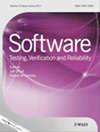第10届IEEE软件测试、验证与验证国际会议(ICST 2017) STVR专刊社论
IF 1.2
4区 计算机科学
Q3 COMPUTER SCIENCE, SOFTWARE ENGINEERING
引用次数: 1
摘要
第十届软件测试、验证和确认国际会议(ICST 2017)于2017年3月13日至17日在日本东京举行。ICST会议的目的是将研究理论、技术、技术和应用的研究人员和实践者聚集在一起,这些理论、技术、技术和应用涉及软件测试、验证和软件系统验证的各个方面。在主要研究项目中,ICST 2017项目主席Ina Schieferdecker和Hironori Washizaki根据项目委员会的推荐,从135份提交的论文中选择了36篇全文论文和8篇短文纳入论文集。所有论文均由至少三名项目委员会成员审阅。在收到的36篇全文中,我们选择了7篇论文作为本期《科学与现实》特刊的参考。这些论文是作者从会议版本中扩展出来的,并按照标准的STVR审查程序进行了审查。我们感谢所有ICST和STVR审稿人的辛勤工作。三篇论文成功地完成了审查过程,并包含在本期特刊中。这篇社论的其余部分提供了这三篇论文的简要概述。第一篇论文——Alireza Salahirad、Hussein Almulla和Gregory Gay撰写的“为工作选择适应度函数:自动生成检测实际故障的测试套件”——研究了不同适应度函数在基于搜索的单元测试生成中检测故障的有效性。对来自Defects4J数据库的真实故障的实验结果表明,分支覆盖适应度函数是最有效的。研究还表明,与检测可能性有关的最重要因素是所选标准的测试义务的满足。第二篇论文——“使用符号执行的复杂性漏洞分析”——Kasper Luckow、Rody Kersten和Corina Pasareanu提出了一种用于分析程序最坏情况复杂性的符号执行技术。该技术使用路径策略将符号执行引导到最坏情况路径。评估结果表明,该技术既能检测出现实软件中的复杂漏洞,又能检测出经典算法的标准实现。第三篇论文——“基于模型的Apache ZooKeeper测试:基本API使用和观察者”,作者是Cyrille Artho、Kazuaki Banzai、Quentin Gros、Guillaume Rousset、Lei Ma、Takashi Kitamura、Masami Hagiya、Yoshinori Tanabe和Mitsuharu Yamamoto——提出了一种基于模型的测试技术,用于生成对ZooKeeper执行并发客户端会话的测试用例。该技术在ZooKeeper和测试oracle中定义了观察者的语义,以处理最终导致观察者被触发的事件链。评估表明,该技术可以检测已知缺陷以及实现可能缺陷的种子突变。本文章由计算机程序翻译,如有差异,请以英文原文为准。
Editorial for the special issue of STVR on the 10th IEEE International Conference on Software Testing, Verification, and Validation (ICST 2017)
The 10th International Conference on Software Testing, Verification, and Validation (ICST 2017) was held on March 13 to 17, 2017, in Tokyo, Japan. The aim of the ICST conference is to bring together researchers and practitioners who study the theory, techniques, technologies, and applications that concern all aspects of software testing, verification, and validation of software systems. In the main research program, the ICST 2017 program chairs, Ina Schieferdecker and Hironori Washizaki selected 36 full papers and 8 short papers for inclusion in the proceedings from among 135 submissions based on the recommendation of the program committee. All papers were refereed by at least three program committee members. Of the 36 full papers accepted, we selected seven papers for consideration for this special issue of STVR. These papers were extended from their conference version by the authors and were reviewed according to the standard STVR reviewing process. We thank all the ICST and STVR reviewers for their hard work. Three papers successfully completed the review process and are contained in this special issue. The rest of this editorial provides a brief overview of these three papers. The first paper ‐ “Choosing The Fitness Function for the Job: Automated Generation of Test Suites that Detect Real Faults” by Alireza Salahirad, Hussein Almulla, and Gregory Gay ‐ studies the effectiveness of different fitness functions in search‐based unit test generation for detecting faults. Experiment results on real faults from the Defects4J database reveal that the branch coverage fitness function is the most effective. The study also reveals that the most important factor related to the likelihood of detection is the satisfaction of the chosen criterion’s test obligations. The second paper ‐ “Complexity Vulnerability Analysis using Symbolic Execution” ‐ Kasper Luckow, Rody Kersten, and Corina Pasareanu ‐ presents a symbolic execution technique for analyzing the worst‐case complexity of programs. The technique uses path policies to guide the symbolic execution towards worst‐case paths. The evaluation shows that the technique can detect complexity vulnerabilities in realistic software as well as standard implementations of classic algorithms. The third paper ‐ “Model‐based Testing of Apache ZooKeeper: Fundamental API Usage and Watchers” by Cyrille Artho, Kazuaki Banzai, Quentin Gros, Guillaume Rousset, Lei Ma, Takashi Kitamura, Masami Hagiya, Yoshinori Tanabe, and Mitsuharu Yamamoto ‐ presents a model‐based testing technique to generate test cases for concurrent client sessions executing against ZooKeeper. The technique defines the semantics of watchers in ZooKeeper and the test oracle to handle the chain of events that eventually leads to the watcher being triggered. The evaluation shows that the technique can detect known defects as well as seeded mutations that implement possible flaws.
求助全文
通过发布文献求助,成功后即可免费获取论文全文。
去求助
来源期刊

Software Testing Verification & Reliability
工程技术-计算机:软件工程
CiteScore
3.70
自引率
0.00%
发文量
34
审稿时长
>12 weeks
期刊介绍:
The journal is the premier outlet for research results on the subjects of testing, verification and reliability. Readers will find useful research on issues pertaining to building better software and evaluating it.
The journal is unique in its emphasis on theoretical foundations and applications to real-world software development. The balance of theory, empirical work, and practical applications provide readers with better techniques for testing, verifying and improving the reliability of software.
The journal targets researchers, practitioners, educators and students that have a vested interest in results generated by high-quality testing, verification and reliability modeling and evaluation of software. Topics of special interest include, but are not limited to:
-New criteria for software testing and verification
-Application of existing software testing and verification techniques to new types of software, including web applications, web services, embedded software, aspect-oriented software, and software architectures
-Model based testing
-Formal verification techniques such as model-checking
-Comparison of testing and verification techniques
-Measurement of and metrics for testing, verification and reliability
-Industrial experience with cutting edge techniques
-Descriptions and evaluations of commercial and open-source software testing tools
-Reliability modeling, measurement and application
-Testing and verification of software security
-Automated test data generation
-Process issues and methods
-Non-functional testing
 求助内容:
求助内容: 应助结果提醒方式:
应助结果提醒方式:


